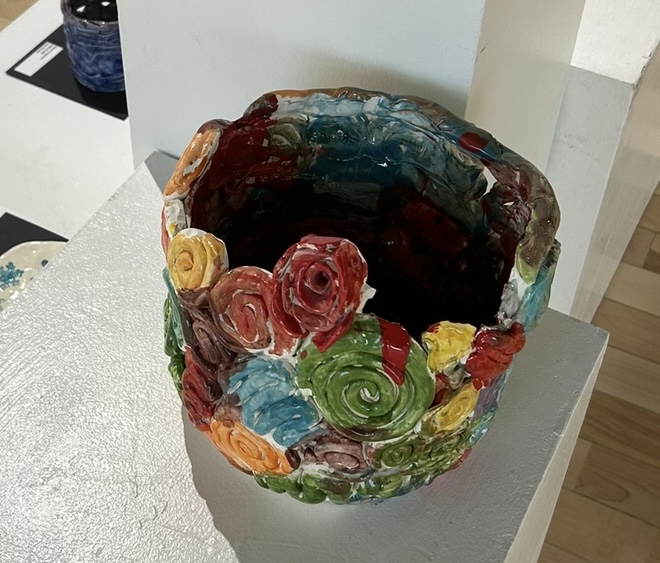Crazy Coil Pot

Meet The Teacher: Ellie Henderson
I am a 5th and 6th grade art teacher. This is my first year teaching but have been a ceramic artist for many years.
Project Description
The Coil Pot Experimentation Challenge is designed to provide students with a dynamic and engaging experience in ceramic art, fostering creativity, collaboration, and technical skill development. This challenge aligns with the principles of experiential learning, allowing students to explore the versatile medium of clay.
Grade Level
Middle School
Difficulty
Intermediate
Student Hands-On Time
60
Teacher Prep Time
30 minutes
Project Cost / Cost Per Student
2
National Core Arts Standards - Visual Arts
- Creating - Generate and conceptualize artistic ideas.
- Creating - Organize and develop artistic work.
- Responding - Perceive and analyze artistic work.
21st Century Skills
- Critical Thinking & Problem-Solving
- Creativity & Innovation
- Collaboration
- Flexibility & Adaptability
STEAM Education
- Arts
Differentiations and Accommodations
Differentiation
IEP
Accommodation
Provide additional guidance and support for students who may require more assistance with coil-building techniques Provide adapted tools for students with motor skill challenges, such as larger handles or tools designed for easier grip. Ensure all students can comfortably use the tools provided. Use visual aids, step-by-step diagrams, or written instructions with visual cues to support students who benefit from visual learning or have language-based learning differences
Learning Objectives: Knowledge
Students will engage in a playful and experimental exploration of coil pot-building techniques, fostering creativity, teamwork, and problem-solving skills.
Learning Objectives: Skills
Problem-Solving: Develop problem-solving skills by overcoming challenges in the experimental process. Tool Proficiency: Gain proficiency in using various decorating tools for coil pot construction.
Learning Objectives: Attitudes/Values
Goal 1: Develop self-awareness and self-management skills to achieve school and life success. C. Demonstrate skills related to achieving personal and academic goals.Encourage students to reflect on their creative choices during the experimentation challenge. Discuss their feelings, challenges, and successes. This promotes self-awareness as they recognize their preferences, strengths, and areas for growth.
Formative Assessment
Formative Assessment: Provide feedback on students' coil-building techniques during the activity. Offer guidance on achieving consistent coil thickness, structural stability, and attention to detail.Formative Assessment: Observe students during the creative process, noting their willingness to experiment with unconventional ideas. Encourage discussions about their creative choices and intentions.,
Summative Assessment
Summative Assessment: Evaluate the overall craftsmanship of the final coil pots, considering the technical proficiency demonstrated in coil construction. Summative Assessment: Evaluate the final coil pots during the Show and Tell phase, considering the uniqueness and creativity displayed in each pot.
Reflection and Discussion
Coil Building: Creating ceramic forms by stacking and joining coils or ropes of clay. Texture: The surface quality of an object, often created by manipulating the clay to add patterns, grooves, or raised areas. Form: The three-dimensional shape and structure of the coil pot. Structure: The organization and arrangement of parts that make up the coil pot. Imprint: Pressing an object onto the clay to leave an indentation or pattern. Carving Tools: Instruments used for shaping and cutting clay, often made of wood or metal. Critique: A formal evaluation or discussion of the strengths and weaknesses of a piece of artwork. Collaboration: Working together with others to achieve a common goal, which may apply during group challenges.Listening: students listen attentively to instructions. Encourage active listening by asking questions and addressing any concerns or clarifications. Speaking: During the Show and Tell phase, students verbally present their coil pots to the class. This encourages effective communication as they articulate their creative process, challenges faced, and favorite aspects of their creations. Writing: After the challenge, students will fill out gallery walk critique assignment worksheet Reading: Students read and interpret written instructions for the challenge. This emphasizes the importance of reading comprehension in following the steps and understanding the objectives
Lesson Activities
Introduction
Introduction: (5 minutes) Welcome and Overview Greet the students with enthusiasm and introduce the experimentation challenge. Emphasize the importance of creativity, fun, and collaboration during this activity. Objective Clarification: Clearly state the objectives: To experiment with various coil-building techniques. To explore creative possibilities in form, texture, and decoration. To collaborate and share ideas with peers.
Hands On
Hands-On Activity: Ensure each student has a workspace with clay and a variety of tools Coil Pot Building: Encourage students to take a playful and experimental approach to coil pot building. Instruct them to create a base with a large coil and then build upwards with additional coils, exploring various shapes, sizes, and forms. Encourage students to experiment with assorted decorating tools and textured objects. Emphasize the importance of trying new techniques and pushing creative boundaries.
Interactive Challenege
Interactive Challenges (10 minutes): Set up short challenges to keep the activity engaging and dynamic: Speed Challenge: Build a small coil pot as quickly as possible. Blindfolded Challenge: Try adding a coil or texture blindfolded. Collaborative Challenge: Pair up students to create a coil pot together.
Show and Tell
Show and Tell: (10 minutes) Students will walk around viewing all the coil pots. Using the gallery walk critique worksheet students will pick one coil pot and fill out the sheet. Invite each student to present their coil pot individually - students can use the critique sheet to help respond to classmates' coil pots Encourage them to: Share the inspiration behind their design. Highlight specific techniques Discuss their favorite aspects or surprises in the creative process. Talk about challenges, surprises, or favorite aspects of their creations.
Clean up
Clean Up: Instruct students to clean their workstations, tools, and hands. Discuss drying procedures for clay.


